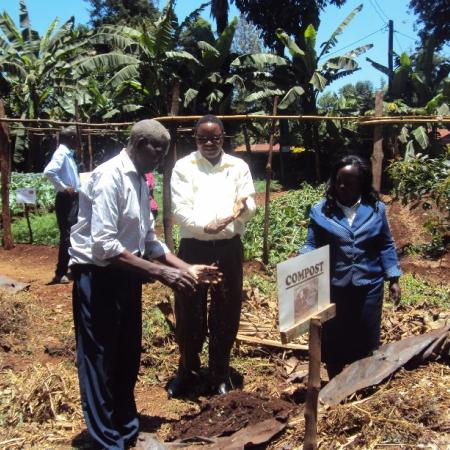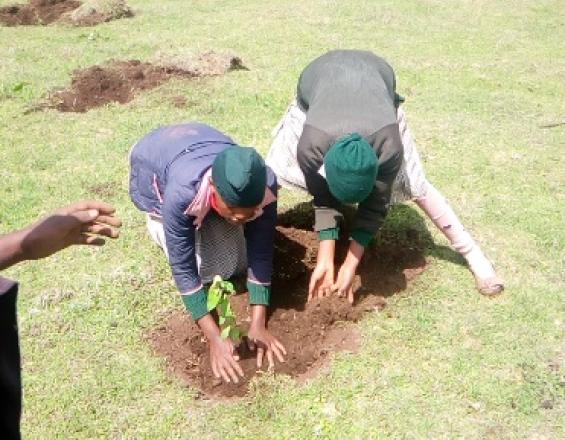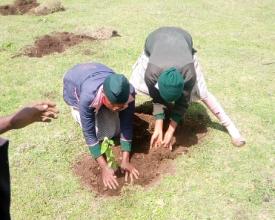
Sustainable Ecological Land Management (SELM)

This solution focuses on improving small-scale farmers value chain for sustainable watershed management, which leads to improved ecosystems that support livelihood and economic development. It is being implememted in partnership with community-based organisations, WRUAs, schools, and county governments.
It targets 1500 households in two sub-counties that are located within the microcatchment areas of Sasumua and Ndakaini Dam, which are the major water reservoirs for Nairobi City.
Project activities include institutional training and on-site training on sustainable ecologic land management (SELM) practices, and rain water harvesting, which is incorporporating water harvesting technologies such as water pans, for efficent water utlization in crop production. It entails also the protection and restoration of riperian ecosystems/zones. To support awareness raising among furture generations, school children receive practical conservation training through the establishment of mini aboretums.
Contexte
Défis à relever
Environmental:
- land degradation
- riperian ecosystem management
- deforestation
- water scarcity
- forest management
- catchment protection
- soil fertility
Social:
- food security
- education
- community cohesion
- talent nurturing
- sports
Economic:
- Poverty eradication
- generating higher income
Emplacement
Traiter
Résumé du processus
Benefit sharing in management of natural resources can have multiple impacts on conservation and community wellbeing. Increased farm productivity and household wellbeing gives communities dignity and confidence to participate in public activities that include e.g. joining associations to collectively manage resources as a common good.
Mutual trust, knowledge and understanding are the basis for building awareness on the importance of the sustainable use of forest resources. Government is taking lead in not only giving communities forest users rights, but also offering participatory management opportunities. This builds strong relationships that can be leveraged to increase reporting, surveilance, protection and utilization of forest resources.
Blocs de construction
Re-discovering Land Productivity
Famers are assisted in prevention, and restoration of degraded lands and ecosystems leading to more land production, increased family income and improved standards of living.
Facteurs favorables
- Land avalilability
- Community cohesion
- Institutional capacity
- Technical expertise
Leçon apprise
- Improving farmer capacity through knowledge and financing for better land management has huge potential in improving family income, food security and livelihood.
- Targeting primary school students for environmental education leads to behavioral change not only among the students but also entire society. Students are voices of change.
Benefit Sharing for Ecosystems Conservation
Communities in two counties formed a Community Forest Association (CFA), which was empowered through training and the sustainable use of non-timber forest products.
They were also trained in surveilance and reporting, while ensuring government officers work in close collaboration with these groups with timely action on any reporting.
Facteurs favorables
- Mutual trust among community members
- Government agencies partneships with local communities
- Paradigm change in forest management that allowed nearby commnunities have user rights, and partcicpate in decision making process
Leçon apprise
- Building mutual trust between communities and government agencies is key in sustainable ecosystems management (forests and riperaian zones included)
- Community capacity building can better monitor natural resources just as well as other institutions due to sense of ownership
Impacts
1. Increased farm productivity
2. Increased farm vegetation/forest cover
3. Reduced siltation into rivers
4. Higher household income
5. Increased food security and nutrition
6. Forest surveilance improved through CFAs engagement
7. Riperian ecosystems restoration enhanced
8. Increased access to knowledge
9. SELM practices has led to heightened land restoration
Bénéficiaires
- 92 primary schools in Muranga and Kinangop sub counties
- 2500 small-holder farmers (men, women, and youth)
- Agricultural extension officers and forest officers
- Commnity Based Organizations (CBOs)
- Community Forst Associations (CFAs)
- Nairobi city
Objectifs de développement durable
Histoire

John lives in Gatanga in Muranga County. The area is home to Ndakaini Dam that supplies Nairobi residents with water. Catchment destruction and perennial droughts had drastically reduced water levels of the dam, and also affected farming practices across the county.
John attended a training organized by SACDEP on sustainable ecologiy land management (SELM) practices, which included surface run off harvesting. This training was conducted prior to the rains. Through this training, John learnt how to construct a water pan and with the help of SACDEP his project was made a reality. This pan allowed John to harvest water when the rains set. With climate change biting hard into farming lands, dry spells deny farmers the opportunity for year-round cultivation. However, John, equipped with the new facility (pan), was bale to continue with his farming activities. Irrigating his land with drip technique enabled a sustainable water use, conservation, and reduced soil erosion.
John' s farm productivity increased because of all-year cultivation, water effiecieny and sustainable farming practices. His household income increased drastically improving his living standards.
With keen eyes of the villagers watching the transformation, John became a self-appointed good will SELM ambassador. 33 farmers within his village, having witnessed the economic progress, joined the programme through John's influence.
These farmers formed a group that underwent training by he SACDEP project officers. With the simple hands-on training they received, these farmers replicated John's technology in their farms. With more farmers signing up, the microcatchment area began to see reduced erosion and land degradation. Riperian enchroachment decreased not to mention increased milk and food supply leading to more nutrition, food variety and increased household income.




